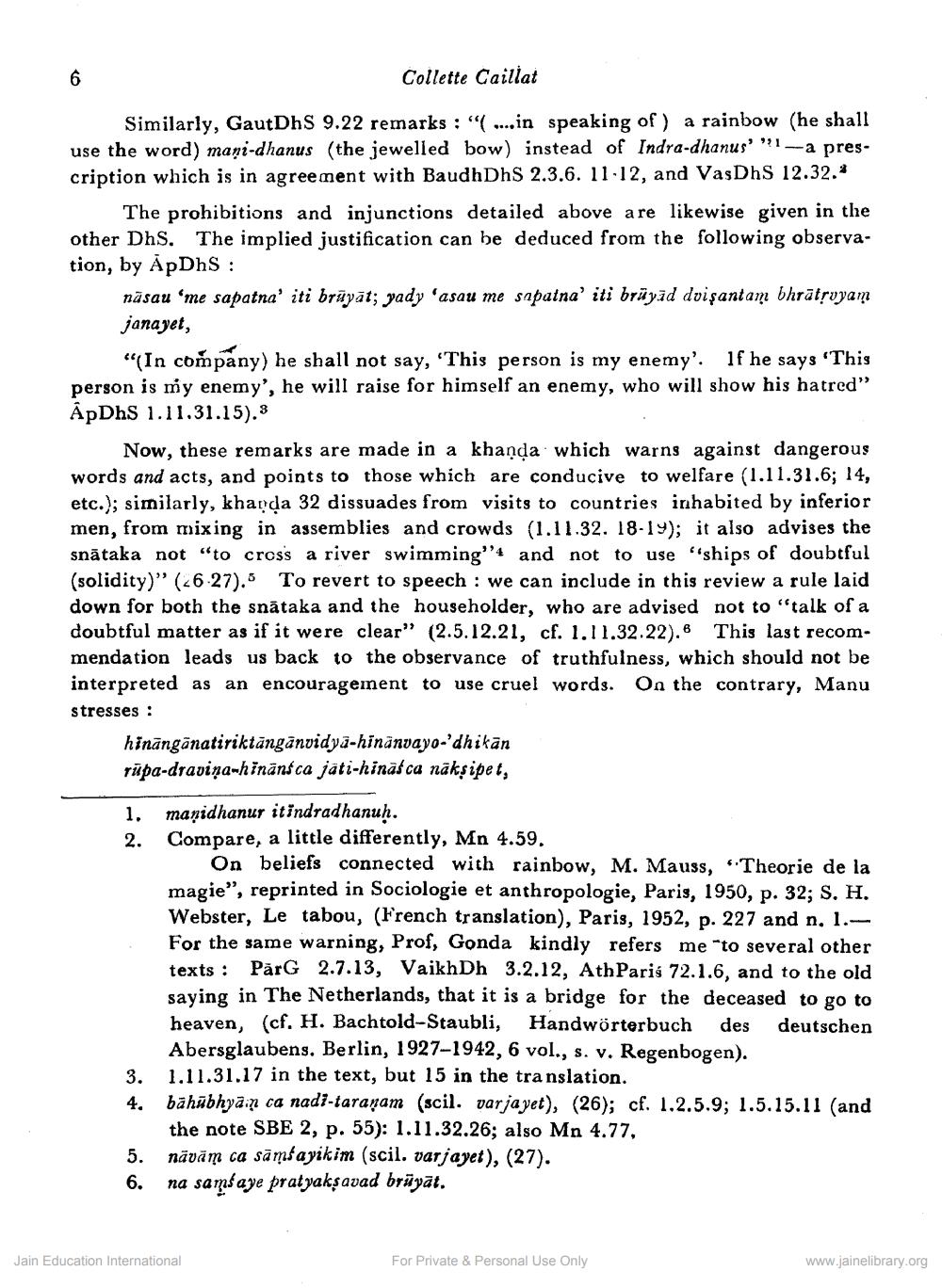Book Title: Rules Concerning Speech in The Ayaranga and Dasaveyaliya Sutras Author(s): Collete Caillat Publisher: Z_Aspect_of_Jainology_Part_3_Pundit_Dalsukh_Malvaniya_012017.pdf View full book textPage 6
________________ Collette Caillat Similarly, GautDhS 9.22 remarks :"( ....in speaking of a rainbow (he shall use the word) mani-dhanus (the jewelled bow) instead of Indra-dhanus'!!!-a prescription which is in agreement with Baudh DhS 2.3.6. 11.12, and VasDhS 12.32.* The prohibitions and injunctions detailed above are likewise given in the other Dhs. The implied justification can be deduced from the following observation, by ApDhS : näsau 'me sapatna' iti brüyāt; yady 'asau me sapatna' iti brüyad dvişantam bhrātsvyam janayet, "In company) he shall not say, 'This person is my enemy'. If he says "This person is my enemy', he will raise for himself an enemy, who will show his hatred” ApDhS 1.11.31.15).3 Now, these remarks are made in a khanda which warns against dangerous words and acts, and points to those which are conducive to welfare (1.11.31.6; 14, etc.); similarly, khanda 32 dissuades from visits to countries inhabited by inferior men, from mixing in assemblies and crowds (1.11.32. 18-19); it also advises the snātaka not "to cross a river swimming"'4 and not to use "ships of doubtful (solidity)" (26-27). To revert to speech : we can include in this review a rule laid down for both the snātaka and the householder, who are advised not to "talk of a doubtful matter as if it were clear" (2.5.12.21, cf. 1.11.32.22). This last recommendation leads us back to the observance of truthfulness, which should not be interpreted as an encouragement to use cruel words. On the contrary, Manu stresses: hināngānatiriktāngānvidyā-hinänvayo-'dhikan rūpa-dravina-hināns ca jäti-hinašca nāksipet, 1. manidhanur itindradhanuḥ. 2. Compare, a little differently, Mn 4.59. On beliefs connected with rainbow, M. Mauss, "Theorie de la magie", reprinted in Sociologie et anthropologie, Paris, 1950, p. 32; S. H. Webster, Le tabou, (French translation), Paris, 1952, p. 227 and n. 1.For the same warning, Prof, Gonda kindly refers me to several other texts : PārG 2.7.13, Vaikh Dh 3.2.12, Ath Paris 72.1.6, and to the old saying in The Netherlands, that it is a bridge for the deceased to go to heaven, (cf. H. Bachtold-Staubli, Handwörterbuch des deutschen Abersglaubens. Berlin, 1927-1942, 6 vol., s. v. Regenbogen). 3. 1.11.31.17 in the text, but 15 in the translation. 4. bāhūbhyain ca nadi-taraṇam (scil. varjayet), (26); cf. 1.2.5.9; 1.5.15.11 (and the note SBE 2, p. 55): 1.11.32.26; also Mn 4.77, 5. nāvām ca sāmśayikim (scil. varjayet), (27). 6. na samé aye pratyaksavad brüyāt. Jain Education International For Private & Personal Use Only www.jainelibrary.orgPage Navigation
1 ... 4 5 6 7 8 9 10 11 12 13 14 15
